Wing infantry armor (part 4)
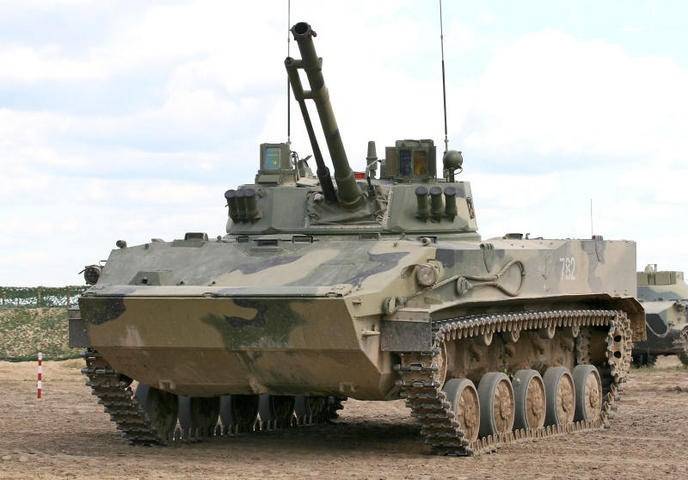
The discontinuation of the mass production of BMD-1997 in 3 did not mean the curtailment of work on the improvement of airborne armored vehicles. To increase the combat potential at the design stage of the BMD-3, it was planned to install a turret with an armament complex from the BMP-3. The topic was returned at the end of 90-x, and in 2001, specialists from the Tula Instrument Engineering Bureau (KBP) and together with an experienced Volgograd Tractor Design Bureau, as part of the Bakhcha-U program, a combat module was installed on the base of the BMD-3 case. with 100-mm and 30-mm guns, as well as 7,62-mm machine gun. All weapons collected in a double tower.
The 100-mm 2А70 30-mm gun, the 2А72 automatic cannon, to the left - the 7,62-mm PKT or PKTM machine gun are located in the turret in a single stabilized block. Designers KBP managed to squeeze different-sized weapons in a fairly compact tower. The armament unit has a length of 3943 mm, width over axles of 655 mm, weight 583 kg. Vertical guidance angles - from -6 to + 60 °. The frontal part of the tower is reinforced with steel armor plates. There is an air gap between the main aluminum and additional steel armor.
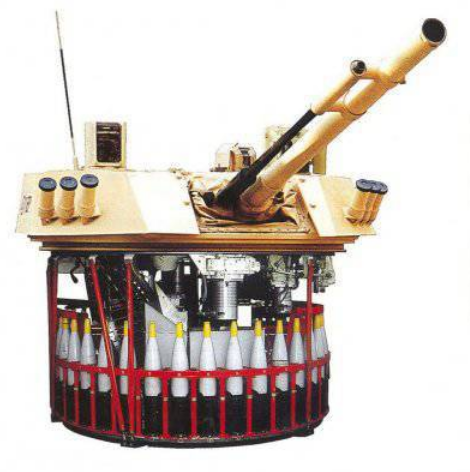
The 100-mm 2A70 low-ballistic gun with a vertical wedge shutter is equipped with an automatic loader. Thanks to this, the combat rate of fire is 8-10 rds / min. In addition to high-explosive shells, the ammunition includes ZUBK23-3 rounds with the 9M117M1 Arkan ATGM with a tandem warhead. Laser-guided anti-tank missile system is capable of hitting targets at ranges up to 5500 m. The thickness of the penetrated homogeneous armor after overcoming dynamic protection is up to 750 mm. Ammunition 100 mm guns include shots with high-explosive shells. The striking ability of high-explosive fragmentation grenades 3OF32 shot early modification 3UOF17 was at the level of high-explosive fragmentation grenades 53-OF-412 used in 100 mm tank gun D-10T. Currently, a new 2UOF70-3 ammunition with a 19OF1 high-explosive fragmentation grenade can be used for firing from a 3A70 gun. Compared to 3OF32, the initial speed increased from 250 to 355 m / s, and the firing range from 4000 to 7000 m. Although the mass of the new grenade decreased from 18,2 to 15,8 kg, due to an increase in the filling ratio and the use of a more powerful explosive the damaging effect has increased markedly. An increase in the firing range of a high-explosive fragmentation projectile makes it possible to support the actions of paratroopers by fire from closed positions.
100-mm gun 2А70 is a powerful tool to combat armored vehicles, destroy the fortifications and enemy manpower, comparable in effectiveness to specialized self-propelled artillery installations and tank guns. The 100-mm ammunition has 34 unitary shells, including four rounds with an ATGM. In parallel with the 100-mm guns, 30-mm 2А72 cannon and 7,62-mm PKTM machine gun with 350 fragmentation incendiary and armor-piercing projectiles and 2000 cartridges are used. When firing an 30-mm automatic cannon, it is possible to switch from one type of ammunition to another. The firing range of the 30-mm cannon is up to 2500 m with armor-piercing shells and up to 4000 m - fragmentation-igniting. The Bakhcha-U armament module is designed to destroy not only ground, but also low-flying enemy targets.
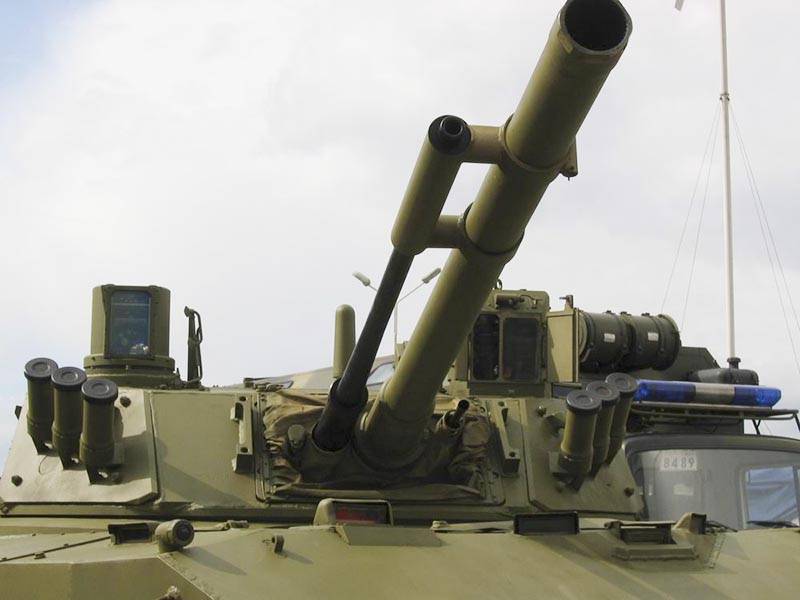
Arms control is carried out by an automated all-daily fire control system (LMS). The vehicle commander and gunner monitor the battlefield using monitors. For aiming weapons, the gunner has an all-day 12-multiple stabilized sight with optical, thermal imaging and rangefinder channels, and an ATGM control channel. Panoramic combined sight of the commander with night and distance measuring channels, allows target designation to the gunner, as well as to conduct aimed shooting with all types of weapons, with the exception of ATGM. After pointing weapons A target tracking machine is used on the target, combined with television and thermal imaging channels of sights. The two-plane weapon stabilizer provides the minimum pointing speed 0,02 degrees / s and maximum transfer speed 60 degrees./s. On the outer surface of the tower there are sensors measuring pressure, temperature, wind direction and speed. Information from them goes to the ballistic computer. In case of failure of fully or partially complex electronic devices, the gunner-operator can use the duplicating sight PPB-2. A circular view in this case will provide periscopic observation devices TNPT-2. In the front right side of the body of the airborne assault vehicle, the installation for the RPKS-74 light machine gun was saved, the AGS-17 grenade launcher was dismantled. By analogy with the BMD-3, the airborne and stern embrasures for the individual assault weapon are preserved.
According to the tradition, preserved from Soviet times, the car with the new combat module was adopted on the last day of December 2004. In August 2005, the first BMD-4 arrived in the 37-th separate parachute regiment (Ryazan). However, in the process of experimental military exploitation, many shortcomings were revealed. The main complaints were the unreliable operation of the sighting and viewing equipment, the incompatibility of electrical equipment, the quality of manufacture of some parts. Defects manifested in the first machines were eliminated by the joint efforts of the military and representatives of the manufacturer. Identified comments were promptly taken into account, and the serial BMD-4 transferred to the 76 th air assault division (Pskov) caused much less complaints.
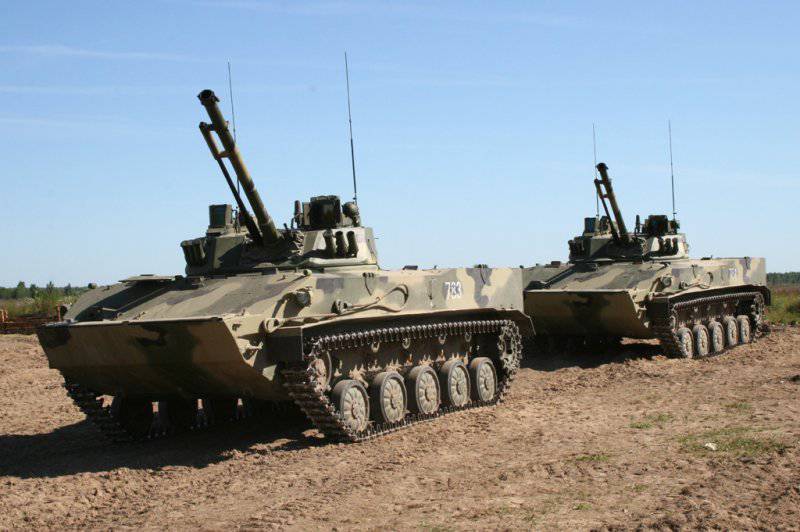
With the exception of the fighting compartment, the BMD-4 retained the layout of the BMD-3. In the department of management along the axis of the machine is the workplace of the driver. To the right and to the left of it are two universal seats, on which the gunner and the commander of the vehicle are located when landing inside the car. On the march these places are occupied by two paratroopers. Behind the fighting is located the troop compartment with three seats for paratroopers, the landing and disembarkation of which takes place through the aft landing bay. The engine compartment occupies the back of the case.
Compared with the previous model, the BMD-4 mass in the combat position has increased by 400 kg. The car has the same four-stroke 6-cylinder diesel engine with turbocharging 2В-06-2 with HP 450 power. Permeability, mobility, and mileage on one refueling remained at the level of BMD-3.
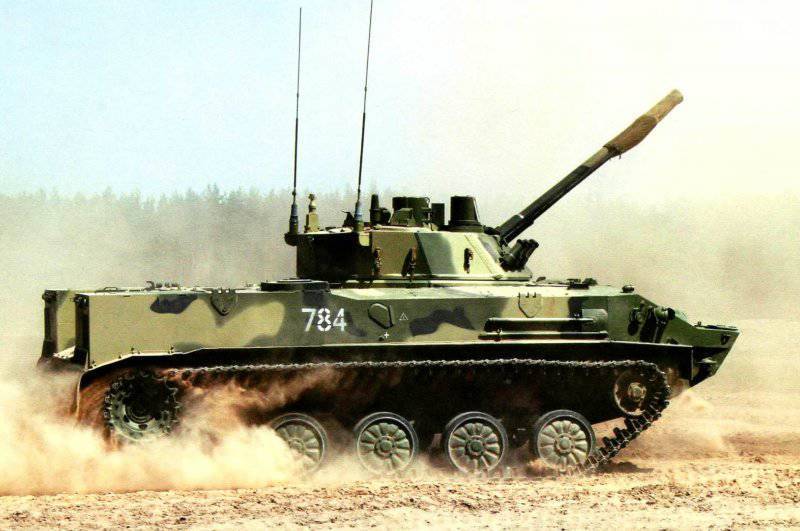
BMD-4 is equipped with modern VHF radio stations P-168-25U and P-168-5УВ, providing radio communication in motion to 20 km. The installation of GLONASS navigation equipment with the display of data on the monitor of the commander is also provided. In the commander version of the BMD-4K, additional means of communication and specially equipped workplaces are provided.
After adopting the BMD-4, mass production of the new machine was established at the plant in Volgograd. However, the lack of orders and the activities of "effective managers" led to the bankruptcy of the enterprise. Before the cessation of production, the troops managed to send 14 machines. After the bankruptcy of the Volgograd Tractor, all documentation was handed over to the Kurgan Machine-Building Plant, where BMP-3 was manufactured. In Kurgan, the Special Design Bureau of Mechanical Engineering (SKBM) BMD-4 was radically reworked and modernized, unifying the power plant, transmission and chassis with the BMP-3.
The BMD-4М case is made of a new light alloy with high ballistic resistance. The hull form itself has changed, the frontal part has become more streamlined, which should help increase the likelihood of a rebound when a projectile encounters armor. The upper frontal and side parts of the hull were reinforced with ceramic armor modules to increase security, and the chassis was covered with additional steel screens. Also by installing an additional screen on the bottom, increased mine resistance.
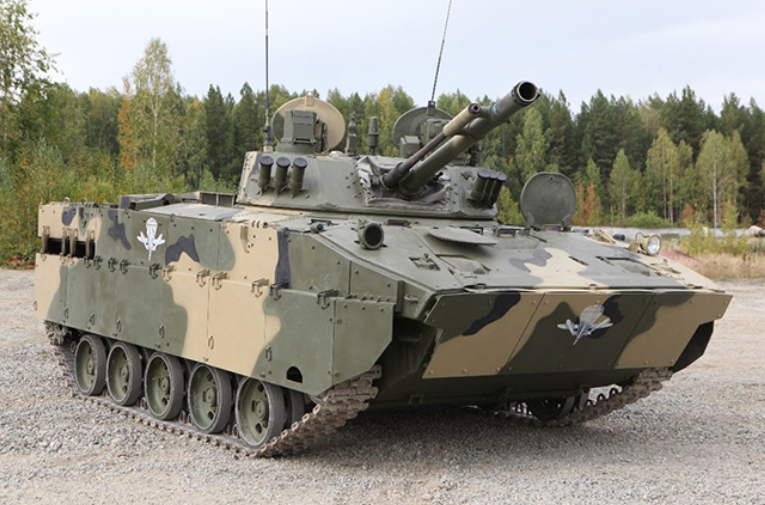
On the updated car, a boxer multi-fuel UTD-29 engine with 500 hp power was installed, which not only increased the mobility and reliability of the machine, but also markedly reduced the dimensions of the engine compartment. Thanks to the reduction in MTO, the capacity of the troop compartment has been increased to 6 people. Also increased the amount of buoyancy. Despite the increase in the number of paratroopers transported and the significant increase in security, the mass of the vehicle compared to the original version of the BMD-4 was reduced by 100 kg and was 13,5 tons. At the same time, the power density increased from 33 to 37 hp / t. The maximum speed on the highway at BMD-4D is 70 km / h. Lifting angle - 35 °. The height of the wall to be overcome is 0,7 m. The width of the forced ditch is 2 m.
Comparative tests of BMD-4M with BMD-4 demonstrated the significant superiority of the modernized machine, and the command of the Airborne Forces expressed a desire to purchase 200 units. However, these plans were hampered by the leadership of the Ministry of Defense of the Russian Federation. As of March 2010, there was no vehicle landing, and the project was frozen. V.A. Popovkin, First Deputy Minister of Defense of the Russian Federation, stated that the BMD-4М, except for the batch intended for tests, had not been received by the Airborne Forces, and the Ministry of Defense refuses their further purchases. The situation changed after the arrival of the new minister, the car was officially put into service in December 2012.
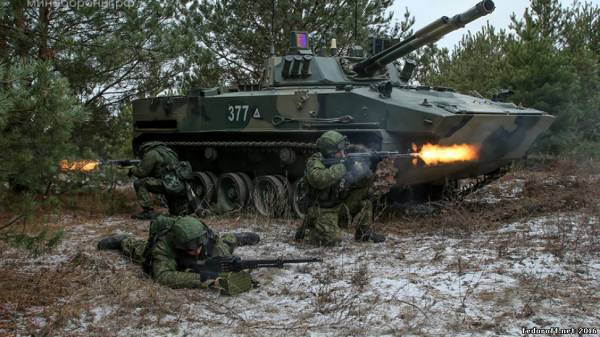
In 2015, the BMD-4M began to enter the army. As follows from media reports, the first batch of BMD-4M arrived at the Ryazan Higher Airborne Command School. In 2017, the 137 Guards Parachute Regiment of the 106 Guards Airborne Division received an 31 vehicle, the first BMD-4M battalion set.
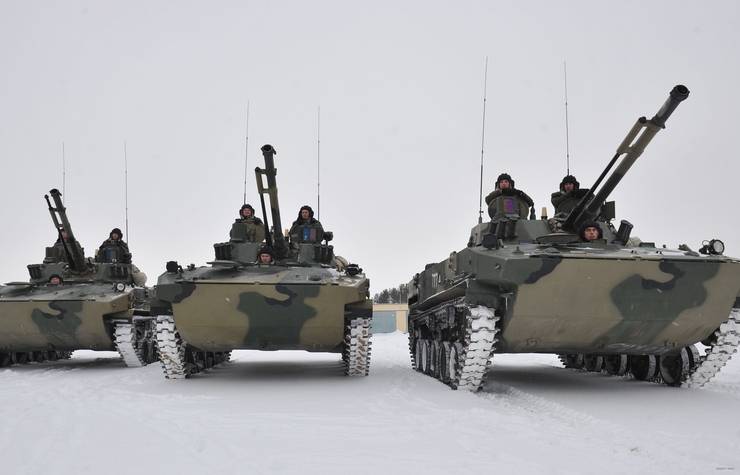
At the end of 2017, the 242 training center for junior airborne specialists in Omsk received an 10 BMD-4М. This year the BMD-4М is planned to recruit two battalions of the 31-th Guards Separate Air Assault Brigade, which is deployed in Ulyanovsk.
In 2002, an armored vehicle for radiation and chemical reconnaissance designed to conduct radiation, chemical and biological reconnaissance units of the airborne forces or marine corps was created in the special design bureau VGTZ in the special design bureau Voztoz. The machine is able to land from aircraft military transport aviationusing existing parachute systems and get to the shore by swimming when leaving the landing ship. Act in conditions of the use of weapons of mass destruction in difficult topographic and meteorological conditions, day and night. Thanks to the equipment on board, the RXM-5 provides the crew with high protection against the consequences of the use of weapons of mass destruction by the enemy.
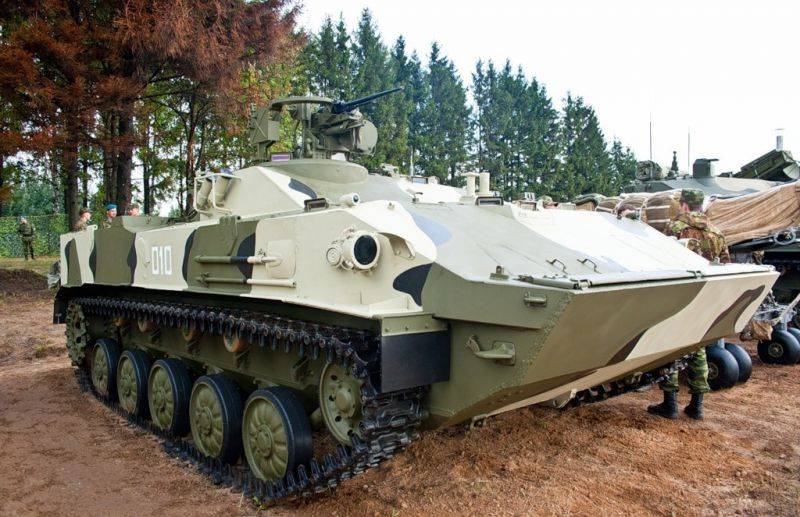
The set of special equipment RBHM-5 includes gas detectors and dose rate meters (IMD). Air purification inside the machine is performed by an air filtration unit with increased productivity. Sensors placed outside the car capture gamma radiation, after which the system of special protection during a nuclear explosion provides automatic sealing of the case, shutting off the main power supply circuits and the engine for the duration of the shock wave. To reduce the radiation dose of the crew, when working with radiation contamination, combined protective anti-radiation screens were installed on the floor of the control compartment and the middle compartment. Inside the hermetic case there are cylinders of a tank degassing kit intended for degassing the chassis of the machine. The presence of drinking water tanks, food supplies and a dry closet, allows the crew to not leave the car in terms of actions on contaminated areas. The equipment of inertial and satellite navigation of the GLONASS system is used for orientation on the terrain and laying the route. The machine is also equipped with modern means of processing and transmitting data, setting the triggering of chemical alarm signals, radio stations P-163-50U and P-163-UE, as well as T-236-B information classification equipment. For self-defense, on the roof of a rotating commander's turret, an 7,62-mm caliber machine-gun installation with remote control and external power supply is installed. On the sides of the cabin there are six smoke grenade launchers "Cloud".
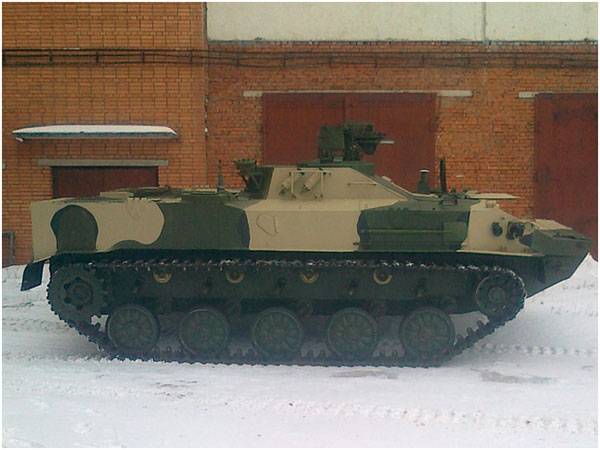
Externally, the car differs from the BMD-3 (BMD-4) form of the body. To accommodate special equipment, a multifaceted welded armored housing rising to 350 mm is welded to the roof of the hull. In the cabin there are workplaces of the commander and senior chemist, as well as special equipment is placed and there are intake and outlet openings for taking air and aerosol samples from the atmosphere.
The machine for radiation and chemical reconnaissance can be parachuted parachuted with four crew members inside. It is possible to transport the РХМ-5 on the external suspension of the Mi-26 helicopter. The mass in the combat position - 13,2 t, and the driving characteristics are generally similar to the base car.
In 2009, the PXM-5 was tested in the Tula 106 airborne division. According to information published on the Concern Tractor Plants website, the PXM-5 assembly from 2012 has been carried out at the production facilities of Tula Plant OJSC. However, the number of cars produced is very small, according to The Military Balance 2017, the entire 6 PXM-5 was delivered to the troops. They are used in the radiation, chemical, and biological defense units of the 76 airborne assault and 106 airborne divisions.
Not so long ago, information appeared that on the basis of the BMD-4M a mobile air-transportable short-range air defense complex "The Birdies" is being created. A big problem with the developer of the airborne air defense system is the safety of quite fragile units, electronic-optical circuits and blocks of the complex, because the landing of a multi-ton machine with parachutes can be called only conditional. The speed of dropping the parachute is extinguished, though, but landing from a height is always accompanied by a serious blow to the ground, therefore all vital components and assemblies are necessarily protected and strengthened.
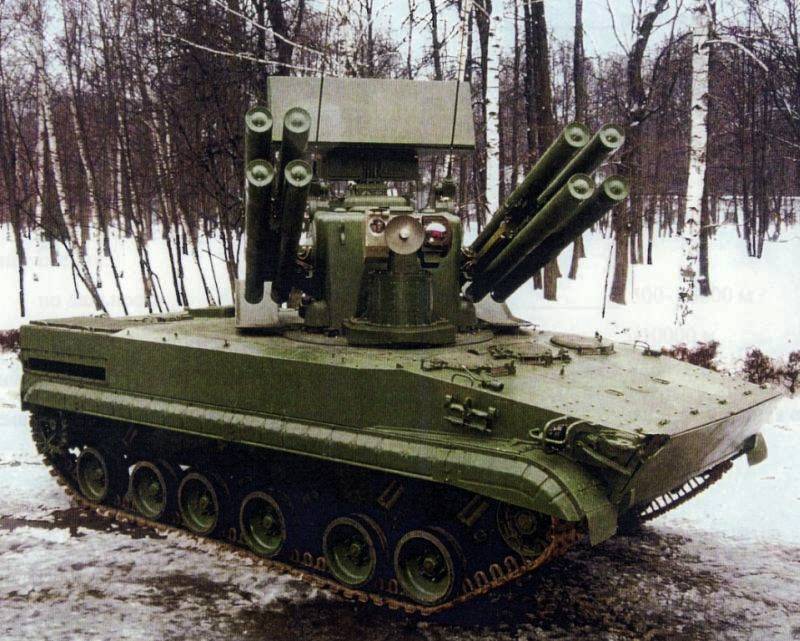
The details of the project are not known, however, in the past, the Tula Instrument Design Bureau based on BPP-3 and BMD-3 designed the air defense system using the elements of the ZRPK Pantsir-S. In a number of sources it is said that the new air defense complex for the airborne forces will be created on the basis of the Sinas air defense missile system with laser-guided missiles. According to information provided by the Federal State Unitary Enterprise "Design Bureau of Precision Engineering to them. A.E. Nudelman ”biklibernaya SAM“ Sosna-R ”has a maximum launch range to 10 km, the height of the targets hit 0,002 – 5 km. Shooting at ground targets is also possible. Detection of air targets at a distance of up to 30 km occurs at a survey optoelectronic station, which does not unmask itself with radio frequency radiation.
After adopting the BMD-3, in the framework of the OCR "Shell", the military issued a technical task for the creation of an amphibious armored personnel carrier on the basis of this vehicle. However, due to the lack of funding, the new floating tracked armored personnel carrier BTR-MD was embodied in the metal with a long delay. By analogy with the BTR-D, the new airborne armored personnel carrier differed from the base BMD-3 by increased hull dimensions and the absence of a turret. But unlike the BTR-D, due to the sufficient internal volumes, the car body was not lengthened. At the same time, compared with the BMD-3, the body of the armored personnel carrier became higher by 470 mm.
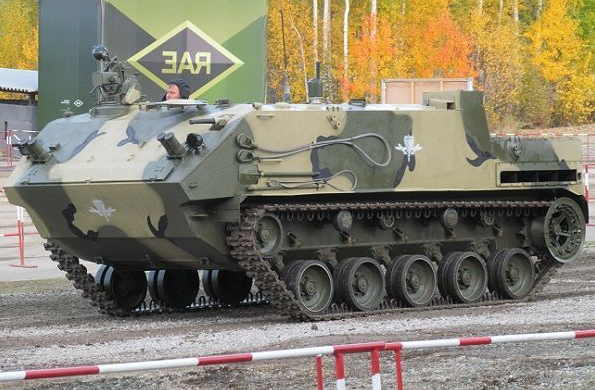
The BTR-MD armored personnel carrier, which appeared in the second half of the 90-x, is arranged according to a scheme with rear-mounted logistics and a front management compartment. The body of the car is welded from armored alloy sheets providing bulletproof protection. Frontal armor holds the bullets of a large-caliber 12,7-mm machine gun, and the side armor maintains shelling of 7,62-mm rifle guns. In the middle front of the case there is a control unit with a driver’s workplace with three periscopic surveillance devices TNPO-170А. In the first version of the machine, the turret of the commander with a machine-gun was on the right side, and the course gun in the left.
On a later modification of the armored carrier, to the left of the driver was mounted a swiveling commander's turret with a TKN-ZMB surveillance device, an OU-ZGA illuminator, periscopic surveillance devices TNPT-1 and TNPO-170А. At the top of the turret there is an installation of a remote-controlled PKTM 7,62-mm machine gun with an external power system and an 1P67M sight. A machine gun can be fired without leaving the reserved space. The seat of the commander of the machine is connected with the upper shoulder strap of the turret and rotates with it. To the right of the driver is a ball mount with a periscope sight-observation device TNPP-220А. The course set can be placed 5,45-mm light machine gun RPKS-74 or machine gun AKS-74. In the upper part of the frontal hull sheet, two grenade launchers of the “Tucha” smoke screen system are mounted. In the roof of an armored personnel carrier there are a large number of hatches, allowing the landing force and crew to quickly load into the vehicle and leave it in any conditions. In front of the upper armor plate cut three separate round hatches. Two more, rectangular, located above the seats for the landing and open up and sideways. The stern hatch, which opens upwards, can be used as an armored shield, under the cover of which the troops can fire from their personal weapons while moving.
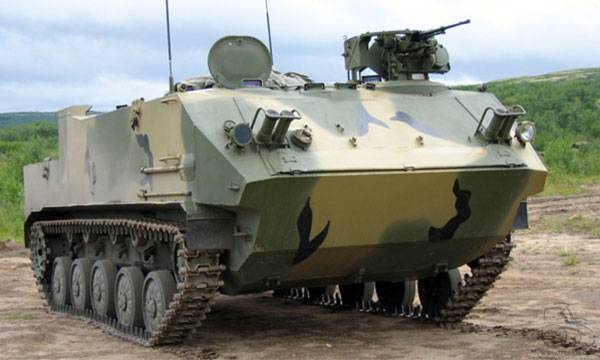
In the sides of the middle part of the hull and in the stern hatch there are three loopholes with armored valves for firing from an individual assault weapon. In the middle part of the armored carrier along the sides are chairs with folding backs for paratroopers. Two more single seats are installed on both sides of the workplace of the driver. In total, the car is equipped with space for the transport of paratroopers 13 with personal weapons. In addition, along the sides there are brackets for transportation of stretchers with wounded. The BTR-MD interior space can be used to transport various cargoes (ammunition boxes, fuel containers, containers with weapons and special equipment), for which there are fasteners in the landing compartment in the form of safety belts with locks. The engine, transmission, chassis and controls of the BTR-MD are mainly borrowed from the BMD-3. Variable ground clearance from 100 mm (minimum) to 500 mm (maximum). The combat weight of the vehicle is 13,2 t. Mobility characteristics and throughput also roughly correspond to BMD-3.
In connection with the bankruptcy of the Volgograd Tractor in 2005, the prospects of the landing armored troop carrier of the new generation were hanging in the air. The base for the upgraded BTR-MDM, created on the “Shell-U” theme, was the BMD-4М, developed in Kurgan. It is difficult to visually distinguish the Volgograd BTR-MD from the Kurgan BTR-MDM at a glance. The overall layout, external shape, weapons and the number of troops they remained the same. The main differences are in the propulsion system and transmission. The Volgograd BTR-MD has an 450 horsepower engine. and the chassis from the BMD-3, and the Kurgan BTR-MDM - inherited the engine in the 500 hp and the transmission from BMD-4M, which gives him a large power density. The undercarriage and tracks of the Kurgan machine have a greater resource, and the bottom is strengthened for greater anti-mine resistance. Communication and navigation are also borrowed from BMD-4M. The most noticeable external differences of armored personnel carriers collected in Volgograd and Kurgan is a different form of road wheels. On the Kurgan car, an embrasure with a machine gun was moved closer to the right edge, and the upper machine-gun installation was somewhat simplified.
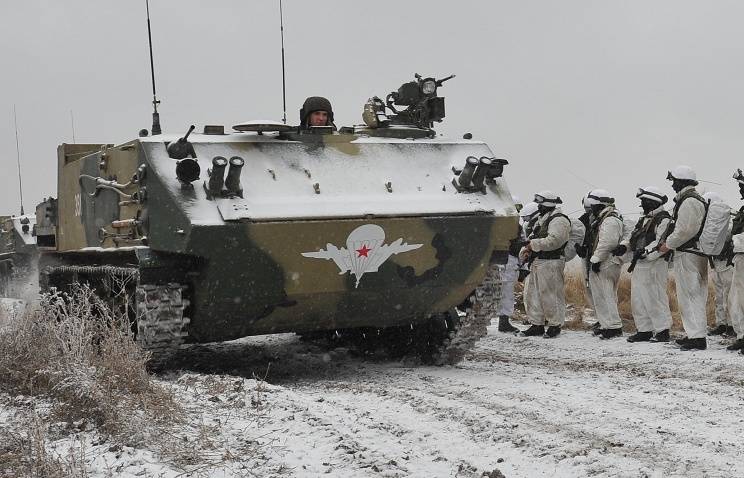
The first batch of 12 BTR-MDM was transferred to the Airborne Forces in March 2015. According to The Military Balance 2017, the troops have only 12 amphibious armored personnel carriers, domestic sources say that such vehicles may be more than 60 units. In 2015, representatives of the Defense Ministry of the Russian Federation stated that the Airborne Forces should receive at least 200 new armored personnel carriers and vehicles based on them.
BTR-MDM was originally designed as a universal platform, on the basis of which you can easily create special airborne aircraft for various purposes. Ambulances were able to be brought to the stage of official adoption and deliveries to the troops.
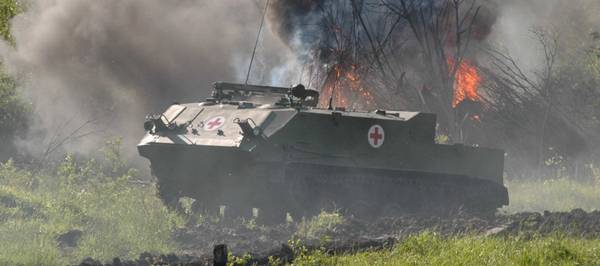
The armored amphibious assault vehicle (ROC Trauma) was created in two versions: BMM-D1 and BMM-D2. The armored ambulance conveyor BMM-D1 is intended for the search, collection and removal of the wounded from the battlefield and the centers of mass sanitary losses with the provision of first aid to them. Inside the BMM-D1 there are 6 seats for the transport of lying injured, or 11 seats for carrying sitting. There is a winch and a crane on the machine to extract the wounded and injured from armored vehicles and hard-to-reach folds of the terrain.
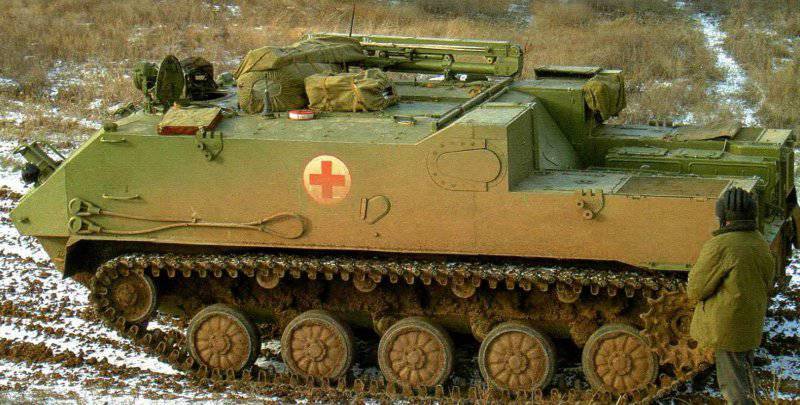
The armored vehicle of the medical platoon BMM-D2 is intended for carrying out measures to provide first aid or first medical aid for urgent reasons and is equipped with a frame tent for 6 injured. The deployment time of the emergency point, with a frame tent no more than 30 minutes.
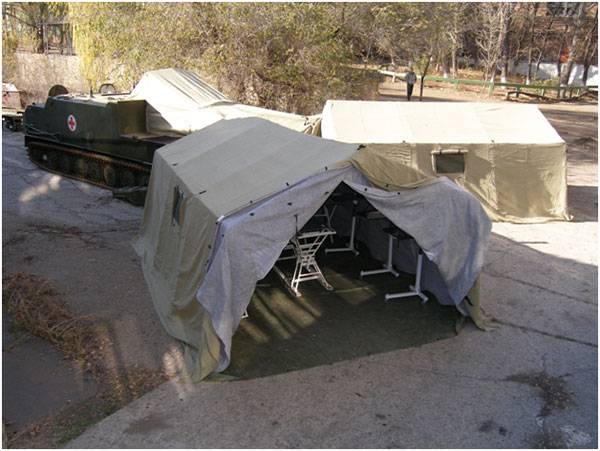
Sources also mention the BMM-D3 mobile dressing station, created on the basis of an elongated base with an additional support roller. But on the adoption of this machine information is not yet available.
To control the actions of the airborne units of the airborne troops, the machine of the MRU-D from the set of the Barnaul-T tactical link automation defense equipment is intended.
At the top of the machine is the antenna-hardware radar detection module of air targets 1Л122-1 with a turntable and four radio antenna communications. The department of control does not differ from the base BTR-MD, but the commander's turret is devoid of a machine gun installation. The possibility of placing a manual machine gun РКСКС-74 in the right side of the frontal sheet is saved. Radar and communications equipment is located in the middle section, and there are jobs for two operators. Phased antenna array on the march is folded inside the machine. To ensure the operation of the equipment in the stern, a compact diesel-electric generator is installed on the left fender.
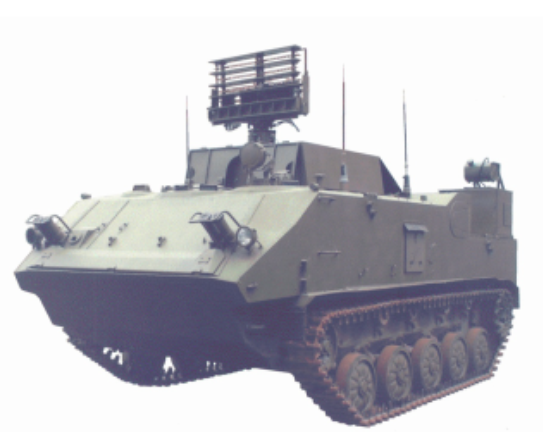
Each operator has an automated workplace based on a PC. Three-coordinate pulse-coherent radar 1Л122-1 operating in the decimeter range provides detection, coordinates and tracking of air targets at a distance of up to 40 km and at an altitude of 10 km. The station is equipped with equipment for determining nationality and can operate in the conditions of active and passive interference by the enemy.
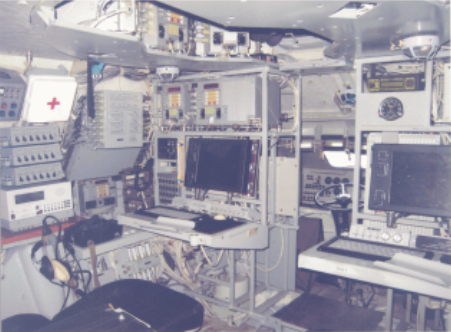
According to the advertising brochures of OAO NPP Rubin, the set of automation and control equipment of the tactical link Barnaul-T allows you to quickly adjust to the available forces and means of any organizational and staff structure of tactical units of air defense units. However, the full realization of the capabilities of the MRU-D machine intended for detecting air targets, issuing target designation and controlling the combat operation of air defense weapons in the airborne forces is currently not possible, due to the lack of airborne anti-aircraft missile systems on the mobile chassis. At the moment, the main means of protecting airborne units from air strikes are Igla and Verba MANPADS.
Apparently, the machine of the MRU-D is in the testing phase, since there is no information about its adoption for use in the Airborne Forces. In February, the press service of the Defense Ministry of the Russian Federation published information 2017 of the year that during the exercises of the Airborne Forces in the Pskov region the newest control complexes “Barnaul-T” were involved for the first time. However, it is not mentioned on which chassis these complexes are located.
During the fighting in Afghanistan, it became clear that BMD-1 is very vulnerable to mine explosions. In this regard, in the second half of the 80-x in the airborne units that were part of the “limited contingent” all light assault vehicles with aluminum armor replaced the BTR-70, BTR-80 and BMP-2Д. The first tank battalion, armed with the 22 T-62, was formed in 1984 in the 103 airborne division.
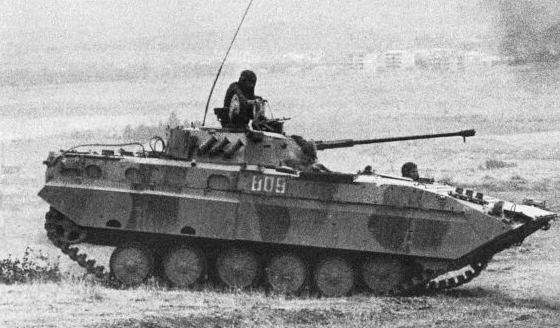
In order to increase security against anti-tank cumulative grenades and 12,7-mm armor-piercing bullets, the BMP-2D was equipped with additional steel screens on the sides of the hull, mounted on bolts at some distance from the main armor, with steel side panels, covering the chassis, as well as armored parts mounted under workers. driver and senior shooter. Ammunition of machine guns paired with a gun increased to 3000 cartridges. As a result of all these changes, the weight of the car increased, as a result of which it lost the ability to swim, which, incidentally, did not matter in the mountain-desert conditions of Afghanistan. In the future, this practice was continued, so in the airborne assault brigades subordinate to the commander of the military district, one battalion was armed with heavy army armored vehicles.
In 2015, it was announced that the formation of separate tank companies had begun in the Russian Airborne Forces. Already in the first half of 2016, two airborne assault divisions (7 and 76) and four airborne assault brigades (11, 31, 56 and 83) began to arrive in T-72B3 - modernized on UVZ cars with new fire control systems, improved armor protection and forced engines. On the basis of individual companies, it is planned to create tank battalions later. In 2018, separate tank battalions must be formed in the 76-th Airborne Division, in the 7-th Airborne Assault Division (mountain) and in one of the airborne assault brigades.
Apparently, the Airborne Command decided in this way to strengthen the assault firepower in the offensive and increase the combat stability in the defense. In the past, tanks were attached as a means of reinforcing the airborne units in Afghanistan and in the two Chechen campaigns. That, in general, was justified when using paratroopers as an elite motorized infantry. However, with high firepower and good security, the T-72B3 weighs 46 t and cannot parachute. Even in Soviet times, there were not enough military transport aircraft capable of simultaneously providing the transfer of all equipment available to the Airborne Forces. Currently, the main part of the An-12 is decommissioned, and the rest complete their life cycle and are used for auxiliary purposes. In the ranks there are about a hundred IL-76, two A-22 and twelve An-124. Military transport Il-76 and An-22 can take on one tank, and An-124 - two. A significant part of the aircraft BTA has a resource close to the limit or in need of major repairs.
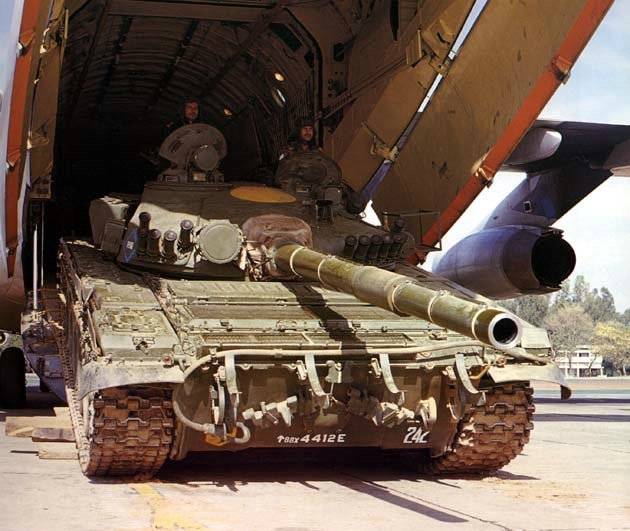
Delivery of T-72B3 tanks is carried out only by landing method on the airfield with a hard surface. It is clear that an emergency transfer to a given area with the help of military transport aviation in our modern conditions can be a very limited number of heavy armored vehicles.
In the 2009 year, to protect against air strikes, mobile air defense systems Strela-10М3 began to arrive at the airborne troops. In 2014-2015, the air defense units received more than 30 upgraded short-range Strela-10MN anti-aircraft missile systems.
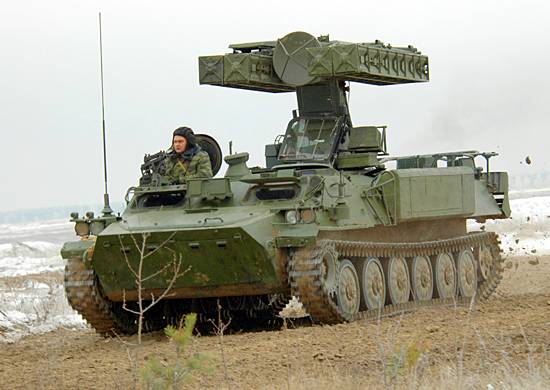
The structure of the upgraded mobile air defense system introduced a thermal imaging system, automatic capture and tracking and block scanning. Thanks to the modified hardware, the complex can operate effectively in the dark and in adverse weather conditions. The multispectral GOS of an anti-aircraft missile has three receivers: infrared (with cooling), photocontrast and interfering with a logical selection of the target against the background of optical interference by trajectory and spectral features. This increases the probability of hitting the target and noise immunity. The mass of the machine in a combat position is about 13 t, which makes it possible to deliver the Strela-10MN air defense missile system with military transport aircraft. However, like the T-72 tanks, all modifications of the Strela-10 air defense missile system can only be landed by landing.
At the last Interpolitex exhibition in October 2017, the latest Russian armored car Typhoon Airborne was presented. As the name implies, the armored car is specially adapted for the needs of the airborne troops and in the future must be parachuted into the air using existing landing craft. Work on this armored car began in 2015, in the framework of the OCR "Typhoon". It was planned to create a landed armored car with a total mass of about 11 t with the wheel formula 4х4 with a capacity of up to eight people. Just five months after the signing of the contract for the creation of a promising machine, in March 2016, the first prototype, designated K4386 "Typhoon Airborne Forces", came out for testing.
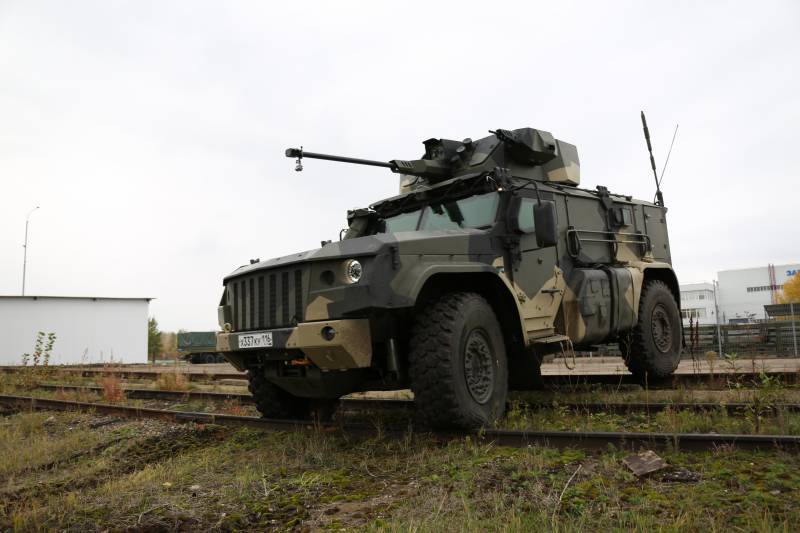
Perspective armored car "Typhoon Airborne", unlike previous machines of its family, is not equipped with a frame for installing the main units, and has a bearing armored body. This solution allowed us to achieve a reduction in weight of about 2 tons and reduce the size, which in turn makes it possible to increase the capacity of the machine and install more serious weapons or other necessary systems on it. Reducing the weight also improves off-road performance.
The armored car has a bonnet layout, the control compartment is not separated from the landing assault by a partition. Metal armor and transparent armored glass protect the units of the vehicle and those inside the paratroopers from bullets of caliber 7,62-mm. It is possible to increase security by installing additional panels of ceramic and polymer armor. The crew and assault seats have a cushioning that absorbs part of the explosion energy under the wheel or the bottom of the hull.
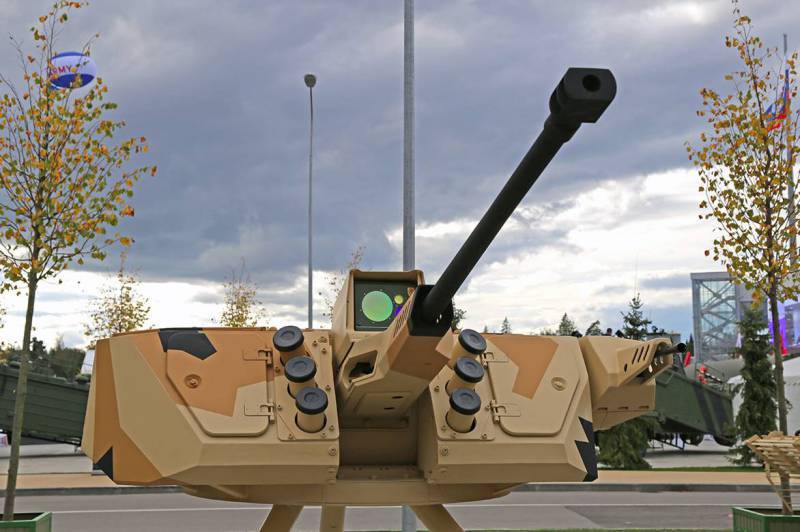
On an armored car being tested and submitted to 2 on June 2016, commander of the airborne forces, VA Shamanov installed a remote-controlled combat module with a 30-mm gun and a 7,62-mm machine gun. The module also contains mortars for setting up a smoke screen.
Under the armored hood of the prototype case, a diesel engine with an 350 horsepower was installed. Cummins, manufactured under license in Russia. However, from statements made by representatives of the developer, on the armored car in the future it is expected to use the engine and suspension elements, whose production at 100% is localized in Russia. The available engine allows the 11 t-armored vehicle to accelerate to 105 km / h and travel at a single filling station along the 1200 km highway.
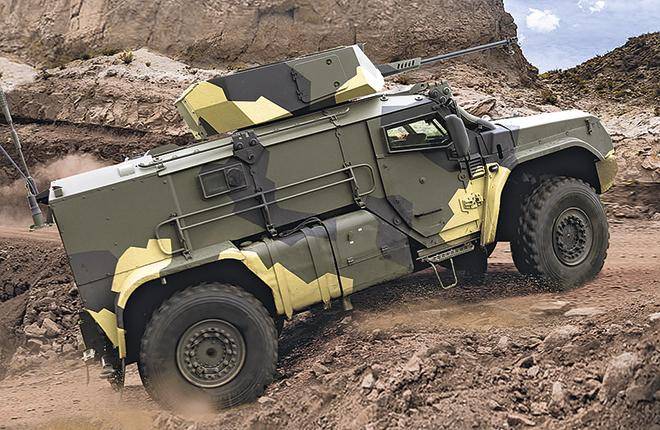
In its current form of armored car, the Typhoon Airborne Troops is a combat vehicle capable of transporting paratroopers with weapons, as well as supporting them with cannon and machine gun fire. In the future, other variants can be created on the basis of this vehicle: carriers of anti-tank systems and anti-aircraft systems, command vehicles, communications and ambulances. In 2017, the K4386 "Typhoon Airborne" passed the final tests prior to its adoption. It is expected that mass production of the armored car will begin in 2019 year.
At the end of the review on domestic armored vehicles armored vehicles, I would like to note that in our country, despite the losses associated with the "optimization" and "reforming" of the armed forces, lack of funding, transfer to private hands and consequently the bankruptcy of a number of defense enterprises, everything it is still possible to create and mass-build the most advanced amphibious assault vehicles. This gives hope that our airborne troops will continue to remain the most powerful airmobile forces in the world. But for this, in addition to equipping them with a perfect armored vehicle with an airborne technology, it is necessary to revive the fleet of military transport aircraft, which is impossible without a change in the domestic political course and a transition to sustainable economic growth rates.
Based on:
http://militaryrussia.ru/blog/topic-828.html
http://www.kbptula.ru/ru/razrabotki-kbp/kompleksy-vooruzheniya-legkobronirovannoj-tekhniki-i-tankov/3uof19
http://modelist-konstruktor.com/bronekollekcziya/boevaya-mashina-desanta-bmd-4
http://army-news.ru/2010/11/bmd-4-i-sprut/
http://vmk.tplants.com/ru/products/ddother/
http://vmk.tplants.com/ru/products/bmm_d/
http://rusplt.ru/sdelano-russkimi/letayuschiy-bronetransporter-btrmdm-rakushka-18869.html
http://army-news.ru/2015/09/razvedyvatelnaya-ximicheskaya-mashina-rxm-5-povozka-d-1/
http://www.npp-rubin.ru/index.php
https://bmpd.livejournal.com/2763342.html
https://tvzvezda.ru/news/forces/content/201605050923-3kli.htm
https://ok.ru/russian.patriot.rf/topic/67251655044018
http://bmpd.livejournal.com/
http://military-informant.com/
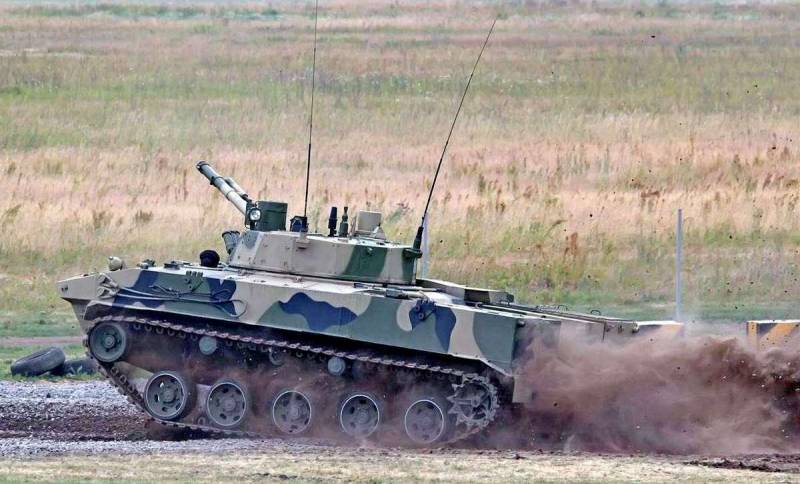
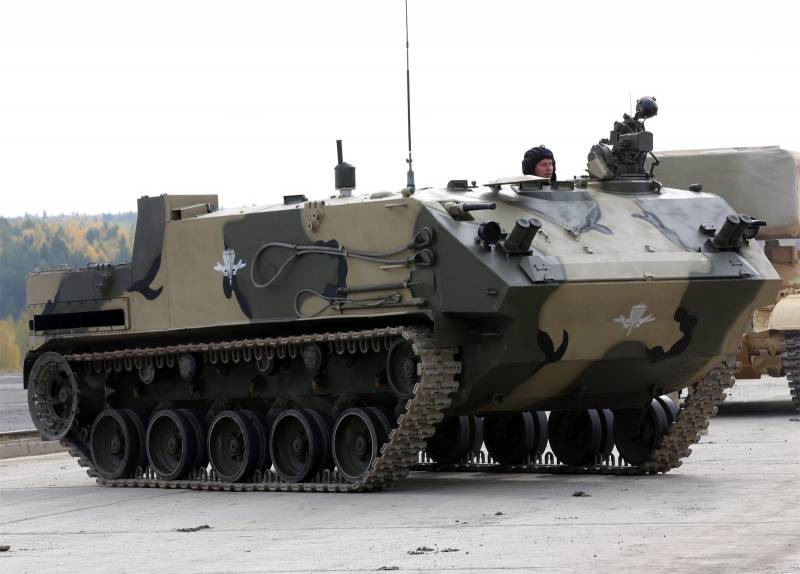
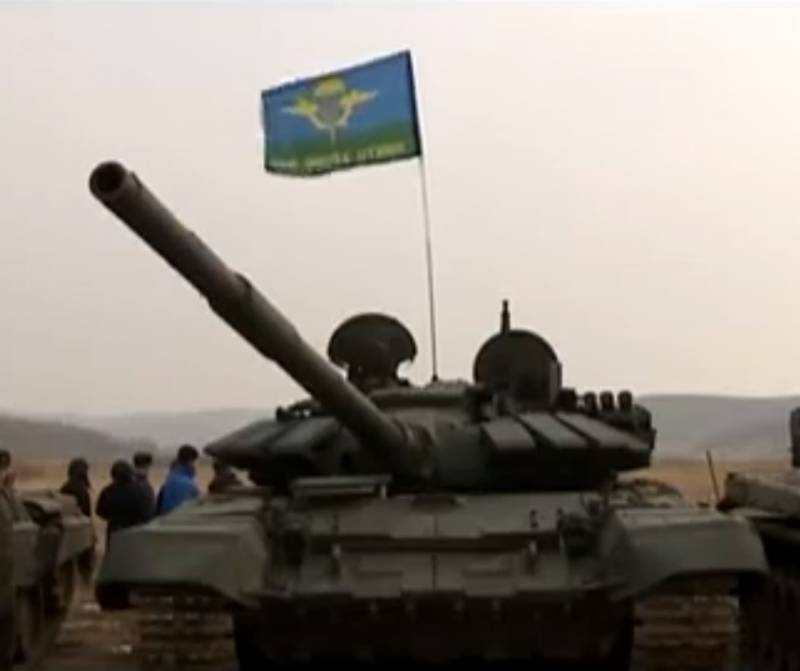
Information